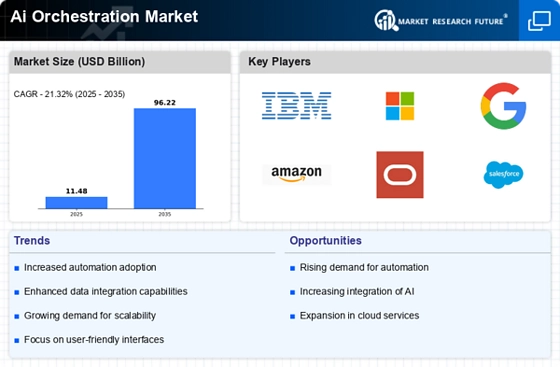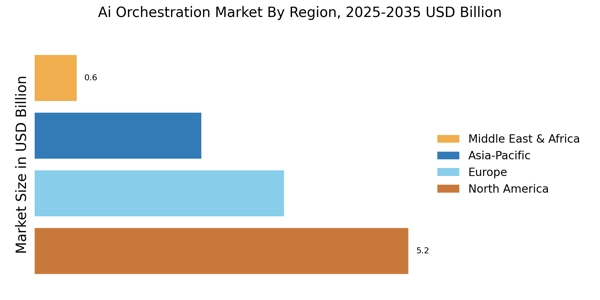The Ai Orchestration Market is currently characterized by a dynamic competitive landscape, driven by rapid technological advancements and increasing demand for integrated AI solutions across various sectors. Major players such as IBM (US), Microsoft (US), and Google (US) are at the forefront, each adopting distinct strategies to enhance their market positioning. IBM (US) focuses on innovation through its Watson platform, emphasizing AI-driven insights for enterprise applications. Microsoft (US) leverages its Azure cloud services to integrate AI orchestration capabilities, thereby enhancing its cloud ecosystem. Meanwhile, Google (US) is concentrating on developing advanced machine learning frameworks that facilitate seamless orchestration of AI models, indicating a strong commitment to research and development. Collectively, these strategies not only intensify competition but also foster a collaborative environment where technological advancements are rapidly shared and implemented.
In terms of business tactics, companies are increasingly localizing their operations to better serve regional markets, optimizing supply chains to enhance efficiency. The competitive structure of the Ai Orchestration Market appears moderately fragmented, with a mix of established players and emerging startups. This fragmentation allows for diverse offerings and innovation, as smaller firms often introduce niche solutions that challenge the status quo established by larger corporations. The collective influence of these key players shapes market dynamics, as they continuously adapt to evolving customer needs and technological trends.
In September 2025, IBM (US) announced a strategic partnership with a leading telecommunications provider to enhance its AI orchestration capabilities in the telecommunications sector. This collaboration aims to integrate AI-driven analytics into network management, potentially revolutionizing how telecom companies optimize their operations. The strategic importance of this partnership lies in its potential to streamline processes and reduce operational costs, thereby positioning IBM as a leader in AI solutions for telecommunications.
In August 2025, Microsoft (US) unveiled a new suite of AI orchestration tools designed specifically for healthcare applications. This initiative reflects a growing trend towards the digital transformation of healthcare services, where AI can significantly improve patient outcomes and operational efficiency. By focusing on this sector, Microsoft not only diversifies its offerings but also addresses a critical market need, thereby enhancing its competitive edge.
In July 2025, Google (US) launched an advanced AI orchestration platform aimed at simplifying the deployment of machine learning models across various industries. This platform is designed to facilitate easier integration of AI into existing workflows, which could potentially lower the barrier to entry for businesses looking to adopt AI technologies. The strategic significance of this launch is profound, as it positions Google as a key enabler of AI adoption, fostering a broader ecosystem of AI-driven solutions.
As of October 2025, the competitive trends in the Ai Orchestration Market are increasingly defined by digitalization, sustainability, and the integration of AI technologies into everyday business processes. Strategic alliances among key players are shaping the landscape, fostering innovation and collaboration. Looking ahead, competitive differentiation is likely to evolve, with a pronounced shift from price-based competition to a focus on innovation, technological advancement, and supply chain reliability. This evolution suggests that companies that prioritize these aspects will be better positioned to thrive in an increasingly complex and competitive market.


















Leave a Comment